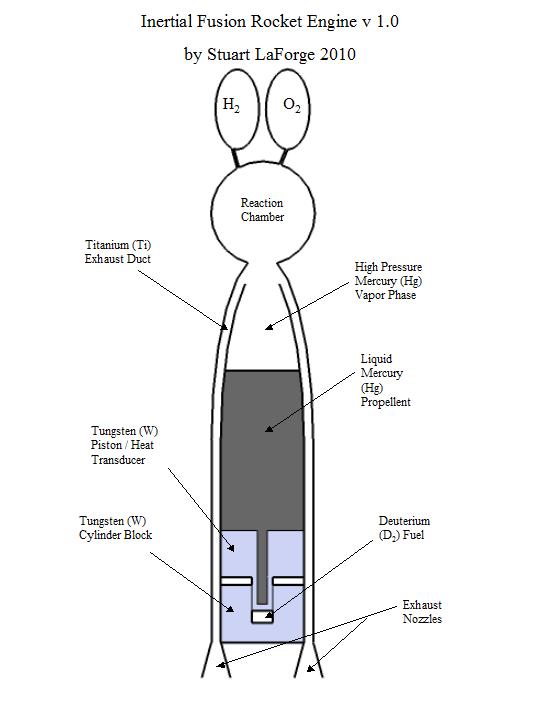
This is a preliminary concept for a fusion rocket that could be built with existing technology. It still has so many problems that I don't consider to it to be of any commercial value yet. The nuclear fusion of the deuterium fuel is primed by a standard chemical rocket engine. Liquid hydrogen and oxygen are sprayed into a standard reaction chamber where they ignite, expand, and release heat. This simultaneously accelerates the rocket and builds up heat and pressure on the nuclear fuel.
The combination of the conventional rocket exhaust and the inertial resistance to acceleration of the heavy mercury propellent and tungsten piston compresses and heats the deuterium fuel in the tungsten cylinder block until it (hopefully) reaches the Lawson criterion for nuclear fusion to become self-sustaining. Once the nuclear fusion reaction is ignited, it should continue vaporizing the mercury which is shunted through the exhaust ducts and out of the exhaust nozzles where it provides thrust and cools the fusion reaction enough that the rocket does not melt or explode. The delta V is theoretically very high. Assuming that the mercury vapor will come close to the temperature of the fusion reaction, the exhaust velocity should be around 1000 km/sec. Assuming that the mass of the craft to be 95% mercury propellent, the delta V should be about 1% the speed of light. While a lighter propellent like water would allow a higher delta V, water would probably not provide enough inertial pressure on the deuterium to ignite and sustain nuclear fusion.
The self-sustaining fusion reaction should fuse the deuterium nuclei into tritium and helium-3. The tritium could then fuse with itself, helium-3, or any remaining deuterium to form helium-4. The helium-3 nuclei could also fuse to form helium-4. In fact several different fusion pathways should occur, all of which eventually lead to helium-4. Thus the fusion should occur for quite a while generating tremendous heat. The tungsten piston's high melting point and strength should allow it to conduct heat efficiently to vaporize the mercury while mainting structural integrity. The vaporizing mercury propellent should continuously accelerate the rocket at high g's which should keep the tungsten piston compressing the nuclear fuel with tremendous pressure allowing the fusion reaction to be contained and continue for some time.
Keep in mind this is still a very preliminary concept and there are some problems with it that I can think of right off the bat. First while no unobtainium is necessary, the components would be rather expensive. Second, once the fusion reaction is started, there would be no way to stop it until the fuel is expended. Third, despite the excellent shielding properties of tungsten, there is still liable to be lots of high-energy neutrons and gamma rays coming off the engine. Fourth it would leave a toxic mercury vapor trail behind it so it probably would not be used in atmosphere. There are probably many more problems with it that a real rocket scientist might see but I did this largely for fun and to explore the concept. I am not aware of any other currently achievable fusion rocket designs out there. The one thing it has going for it is that it is relatively simple compared to fusion reactors currently being worked on earth-side. While I don't see this design ever transporting humans into space, it may be a decent design for unmanned probes to the stars.